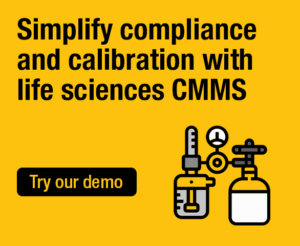Using a CMMS to Demonstrate and Maintain Regulatory Compliance
 Industries such as life sciences require more robust regulatory compliance reporting and auditing than others because of their products’ nature. Product quality has a direct impact on the health of countless individuals. How well manufacturing equipment is maintained thus has an impact as well.
Industries such as life sciences require more robust regulatory compliance reporting and auditing than others because of their products’ nature. Product quality has a direct impact on the health of countless individuals. How well manufacturing equipment is maintained thus has an impact as well.
New and changing regulations require companies to be responsive and innovative. Compliance management is not just a requirement but an opportunity for companies. With a robust compliance program, it’s possible to reduce or eliminate redundancies, identify emerging risks, and improve quality and prioritization.
The life sciences sector includes biotechnology, pharmaceuticals, biomedical, life systems technologies, cosmetics, and medical devices. FDA 21 CFR Part 11 and EudraLex Annex 11 are just some of the rules and regulations that apply to the life sciences industry.
What are FDA 21 CFR Part 11 and EudraLex Annex 11?
 The U.S. Food and Drug Administration (FDA), Drug Enforcement Agency (DEA), and Office on National Drug Control Policy (ONDCP) all use FDA 21 CFR to govern food, drug, cosmetic, and other public health products. Much of the FDA 21 CFR regulates the products themselves, but Part 11 covers explicitly implementing electronic signatures and electronic records standards of use.
The U.S. Food and Drug Administration (FDA), Drug Enforcement Agency (DEA), and Office on National Drug Control Policy (ONDCP) all use FDA 21 CFR to govern food, drug, cosmetic, and other public health products. Much of the FDA 21 CFR regulates the products themselves, but Part 11 covers explicitly implementing electronic signatures and electronic records standards of use.
EudraLex is a collection of rules and regulations governing medicinal products for human and veterinary use. Annex 11 is part of the European GMP guidelines and outlines terms of reference for computerized systems used by organizations in the pharmaceutical industry. Similar to FDA 21 CFR Part 11, EudraLex Annex 11 defines the criteria for establishing electronic records and electronic signatures.
Previously, only paper records could be submitted to the FDA and EudraLex for compliance audits. Paper records are still allowed, but it’s much easier today for organizations to send or display digital documents to an auditor if an electronic system is available.
5 tips to help streamline and ensure regulatory compliance:
- Track work orders
Follow work orders from submission to finalization, with each stage well documented and digitally verified by technicians. Then, when it’s time for an audit, organizations will have detailed compliance evidence, including on-time reports on work order completion rates. - Document best practices procedures
Maintenance managers can attach various documents to eMaint work orders, including safety procedures, equipment diagrams, and manuals. This helps ensure that technicians accurately follow standard work order processes and procedures, including mandated work order sign-offs showing work completion dates. Caris Life Sciences uses eMaint to organize all asset records in preparation for audits to ensure regulatory compliance. - Verify equipment calibration
After the equipment has been repaired, it should be thoroughly tested before returning to service. eMaint documents pre-operational equipment calibration and testing. With this documentation, companies can show auditors that equipment is running optimally and calibrated to all applicable standards. This is especially important for life-saving machinery.
Medline, a medical device manufacturer, leverages eMaint to track and manage critical machine calibrations. With eMaint, Medline has moved from paperwork orders to electronic work orders. - Generate reports
eMaint enables maintenance leaders to create customized dashboards and reports, include charts or graphs, and to export those reports to text or PDF. This detailed reporting provides proof of compliance to auditors and inspectors and improves internal KPI reporting.
HHS offers various support services to the healthcare, resort, and senior living industries. The organization uses eMaint to ensure on-time preventive maintenance and asset reliability by automating PM scheduling and calendar-based maintenance reminders. - Automate update alerts
Remembering to update every record can be challenging. When compliance documentation needs to be updated or assets need safety-related inspections, eMaint can be configured to send automatic reminders to specified maintenance team members. These reminders help organizations stay on top of compliance tasks and ensure audit readiness.
Herbalife, a global nutrition company, uses eMaint to organize records before a planned inspection and assure external audit readiness.
Maintain regulatory compliance with eMaint
Whether it’s FDA 21 CFR 11, EudraLex Annex 11, or other regulations, eMaint helps highly regulated industries improve maintenance best practices, stay prepared for audits or inspections, and approach audits confidently.
Learn how eMaint simplifies the audit process and helps organizations ensure regulatory compliance. Sign up for a free demo.


